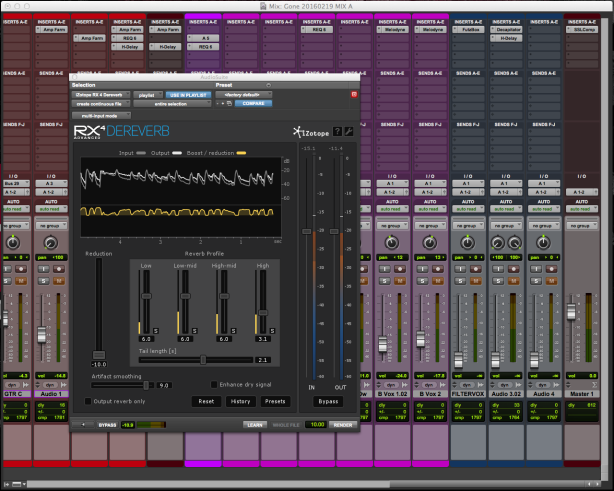I haven’t done a “mixing tip” post in a while and I was working on some drums today and thought I’d share a little technique that I started using recently.
Many of you many not be in an ideal space to record drums; or, like me, you have a great room, but it just isn’t as “big” as you’d like it to be.
I’ve gone through TONS of positions in the room from mic’ing on the floor, to mic’ing up high, to pointing mics at the windows for reflections…..so many different methods. And I’ve also tried so many different MICS. My favorite for drum room by far is the AEA R88 stereo ribbon, hands down. AMAZING mic.
But the mic alone won’t give you that magic “large room” sound. You have to compress the crap out of it! 1176, Distressor, API 527, I’ve tried many different ways, but it still ends up sounding like a smashed small room.
A number of months ago I was working on an audio for video project and the voiceover was done in a less than ideal space. There was WAY too much roominess for a VO. I remembered the new Dereverb tool in Izotope’s bundle and tried it out. It works pretty well… Not mind blowing, but used in moderation it helps a little bit. It’s a good tool for those doing audio post and film work. But while playing with the settings, I found out you can go the OPPOSITE way and actually make the room sound MORE prominent! Immediately I had to try it on drum room mics…..and sure enough, it worked wonders.

The Dereverb tool is essentially a glorified multiband compressor where the only thing you can really change is the threshold and the release. While on some compressors you can do expansion/upward compression (like Wave’s RComp) on Dereverb you can also overly compress the tails and bring up the room sound.
I find it to sound more natural than compression….more like a bigger space. With the right compressor, I’m sure you can get there, but you really have to spend some time dialing in the right settings. You can get a little bit of crunchy artifacts going if you dial too much in, but for most drum room sounds, I’m usually ADDING distortion anyway to be more aggressive/in your face, so I don’t mind this at all.
A couple of things to be mindful of:
– It’s best to dial back the High end because it can get quite crispy on cymbals
– You HAVE to render/process and not leave the plugin on (TONS of latency)
I’ve attached a link with samples below. You will find 3 files.
1. “Room – NO processing” – this is the completely dry signal as recorded
2. “Room – EQ Decap” – this is PRE Dereverb but with my EQ and Decapitator applied
3. “Room – DeReverbed” – this is after all processing including DeReverb
Download DeReverb Samples Here!
Enjoy!
Thanks for the tip! I haven’t used Dereverb yet, though I’ve used RX a lot.
No prob!
Love the Izotope plugins, so smooth sounding